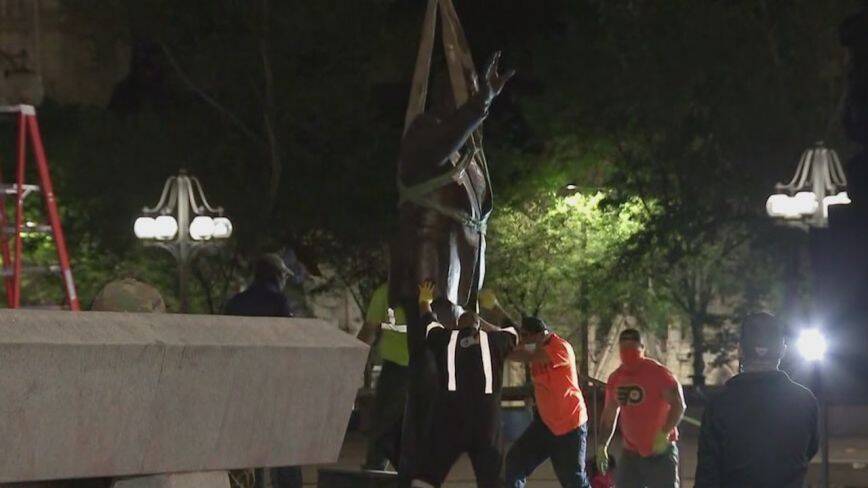
Frank Rizzo statue removed after being a target of Philly protests
It’s a symbolic victory for the movement that’s gripped the city over the last week since the murder of George Floyd in Minneapolis.
On Saturday May 30, as Philadelphia endured its longest day of uprisings in the aftermath of George Floyd’s murder by a police officer in Minneapolis, there was one target of the crowds’ ire that rose above all others in the City of Brotherly Love.
The crosshairs were firmly set on the statue of former Philadelphia Mayor Frank Rizzo, which sat in a prominent spot at the city center in front of the Municipal Services Building.
Rizzo is arguably the polarizing political figure in the modern history of Philadelphia. The former mayor, who served for eight years between 1972 and 1980, was also the police commissioner before taking office.
His policies in both posts put targets on the backs of Philadelphia’s growing black and brown communities for violence and discrimination.
He wasn’t subtle either, once urging voters while running for his third mayoral term to “vote white,” and the pattern of police brutality that existed during his time as police commissioner was the subject of a 1978 Philadelphia Inquirer investigation that netted the paper a Pulitzer Prize.
This legacy of open contempt for black and brown communities in the city made the placement of his statue in Center City across from City Hall in 1999 a slap in the face for those same communities.
On May 30, that slap in the face was thrown back at the city as the bronze statue of Rizzo was burned and defaced during the city’s Justice for George Floyd demonstrations, which have since continued throughout Philadelphia.
The statue was initially the first to be cleaned in the aftermath of the first night of uprising and got a hefty police detail to guard it in subsequent days, further enraging the protesters.
But the action had its effect.
Philadelphia Mayor Jim Kenney also announced the expedited removal of the statue from in front of the Municipal Services Building.
In the early morning hours of June 3, 2020, 21 years after its placement in Center City, a construction crew under the direction of the City Managing Director’s Office removed the statue for placement in storage.
RELATED CONTENT
In a statement released after its removal, Mayor Kenney called the city’s past approach to moving the statue “a mistake.”
“We prioritized efficiency over full recognition of what this statue represented to Black Philadelphians and members of other marginalized communities,” he said.
Kenney continued to label the statue a “deplorable monument to racism, bigotry and police brutality for members of the Black community, the LGBTQ community, and many others.”
“The treatment of these communities under Mr. Rizzo’s leadership was among the worst periods in Philadelphia’s history. The battle for equal rights and justice is still being fought decades later,” he said.
Councilmember Helen Gym, who called for the statue’s removal after the events of Charlottesville, Virginia in 2017, tweeted her support for the Mayor’s words, but acknowledged that more needed to be done to achieve the equal rights and justice he spoke of.
“I appreciate @PhillyMayor’s powerful words. But Philly, we got real work to do to end abusive policing practices that harm the public trust and our public safety,” she wrote. “I’m all in on that work.”
I am glad that wretched monument to bigotry & oppression is gone. I appreciate @PhillyMayor’s powerful words. But, Philly, we got real work to do to end abusive policing practices that harm the public trust and our public safety. I’m all in on that work. #BlackLivesMattter
— Helen Gym (@HelenGymPHL) June 3, 2020
The initial campaign for the statue's removal was started by Philly REAL Justice in Aug. 2016.
The future of the statue is up in the air and in the hands the Department of Public Property, which will hold on to it until a plan for its donation, relocation or disposal is created and approved.











LEAVE A COMMENT: